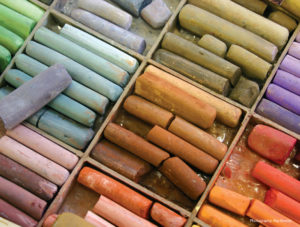When children return to school after the holidays, the playground is often abuzz with stories about road trips to visit grandparents, movies with friends, hanging out at the pool, bike rides, camping with family, conquering of computer games, shopping trips, BBQs or just mooching around in pyjamas.
For some children, however, the holidays may have also included experiences of trauma and loss. Even if children haven’t experienced distressing events directly, they are likely to have been exposed to news coverage on TV, radio, social media and other sources. In Australia, for example, the media has been saturated with images of the devastating bushfires and their impact on people and animals. There’s also been lots of discussion and serious concern about the impact of climate change on the future of the planet.
Parents may have tried to shield children from seeing or hearing too much, however they may have overheard conversations, listened to stories shared by friends or seen footage while out and about.
When words aren’t enough
 Sometimes it can be difficult for children to put words to what they are feeling. Instead, complex emotions may end up being expressed in other ways. Anxiety, stress or trauma may manifest as sensations in the body (body signals) like pains in the tummy, nail biting or hypervigilance, for example. Often, we will notice changes in behaviour like angry outbursts, withdrawal, an inability to concentrate or lethargy.
Sometimes it can be difficult for children to put words to what they are feeling. Instead, complex emotions may end up being expressed in other ways. Anxiety, stress or trauma may manifest as sensations in the body (body signals) like pains in the tummy, nail biting or hypervigilance, for example. Often, we will notice changes in behaviour like angry outbursts, withdrawal, an inability to concentrate or lethargy.
So how can we support children to work through these experiences in constructive ways?
One gentle way to do this is by encouraging children to express their thoughts and feelings through art. As Cathy Malchiodi says in her book, The Art Therapy Source Book:
“Emotions, particularly those that result from trauma, crisis, or loss, are hard to articulate, and often words do not seem to completely convey their meaning. Art can be particularly beneficial in circumstances or complex emotions need to be expressed. The process of making art may help people confront emotions, overcome depression, integrate traumatic experiences and find relief and resolution from grief and loss.” (McGraw-Hill, 2007: p.133)
How art can help?
When confronted with traumatic experiences or content, all of us can be susceptible to feelings of hopeless and powerlessness at times. Children may be less skilled in managing these feelings and emotions constructively.
Cathy notes that art can be a particularly powerful way to reframe and reconceive challenging experiences in a more life-affirming way.
“The language of visual art—colours, shapes, lines, and images—speak to us in ways that words cannot. Art therapy is a modality that uses the nonverbal language of art for personal growth, insight, and transformation and is a means of connecting what is inside us—our thoughts, feelings and perceptions—with outer realities and life experiences.” (ibid: p.ix)
Art can provide a very natural and safe way for children to express themselves. They can play, experiment, make a mess, create stories, use metaphors to represent feelings, explore alternative narratives, externalise their feelings by creating characters, reflect, and share their art with others. They may choose to use colour, texture, different materials, found objects, photographs, collage, sculpture or film, to express themselves. The possibilities are almost endless and can be adapted to suit the individual needs of each child or group of children.
 Some ideas for activities
Some ideas for activities
Here are a few ideas for activities you might like to try in a classroom or in a one-on-one conversation. Parents might like to try these with their children as a way to deepen their connection.
These activities are all strengths-based and solution-focused and are designed to be able to be used in any setting. Please note: all activities deliberately avoid asking the child to draw, depict or re-visit the trauma in any way. (If you are supporting children you know have experienced trauma, please seek support from a qualified counsellor or art therapist with a background in trauma-informed care.)
Some simple, calm-inducing activities any trusted adult might invite a child or children to do:
- Gather a range of tactile materials and images. Create a collage of textures, colours and images that help you to feel calm and happy. What are your favourite colours and textures?
- Using a range of materials, create an image of an imaginary (or real) safe place. Are there other people there? Or pets? Is it inside or outside? What is it made of? Draw yourself inside it.
- Draw or create an image of you as a superhero. What is your super power?
- Trace around your hand. Then fill it with images of all the things that help you feel better when you are feeling sad or angry.
- Draw a self-portrait in the centre of a page. Then surround yourselves with pictures of your strengths and all the things you like about yourself. What do other people say they like about you (friends, parents or teachers)?
Whenever doing activities designed to talk about feelings, please consider how you can ensure that you have created a safe and supportive space for the child. Always focus on their strengths and the circle caring, trusted people they can call on.
We’d love to hear from you about art activities you have used with children. Let us know in the comments below.
Dr. Sue King-Smith
*Some great resources that can be used to talk about feelings and resilience include Anxiety Solutions for Kids, Body Signals, The Bears and Strength Cards for Kids


Thanks so much for your comment, Trish. It sounds like you have used creative tools to help you work through some really challenging experiences. And make some beautiful, reflective and meaningful artwork in the process. I hope your journey continues to be one of transformation and inspiration. Warm regards, Sue
This is a wonderful page, and is the way I have worked on my trauma over the past twenty five years. Art that began as strange squiggles and missing toes and fingers, upside down back to front worlds, slowly became things of interest and meaning and often of beauty. Thank you. Trish
This looks excellent, especially for our locked down families during covid19
ann
Sutherland shire family services.
And I will look into Anxiety solutions for kids and body signals. are they online?
Hello Ann,
We are working hard on making as many resources as we can available online.
Yes we do have both Anxiety Solutions for Kids and Body Signals available digitally, here is a link to have a look at all of the resources available https://myconnectshop.campion.com.au/storefront/searchcatalog.html?search=st+luke%27s&x=10&y=4